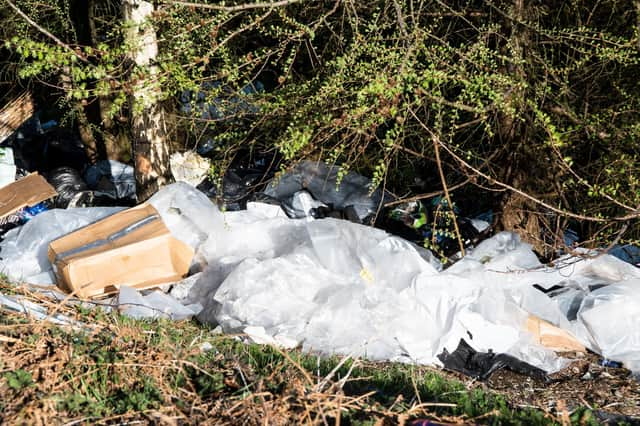The two Northumberland areas behind a rise in fly-tipping in the county


The county council announced a crackdown on the issue earlier this month, which was discussed at the Wednesday, September 16, meeting of the communities and place committee.
In 2019-20, there were 5,040 recorded incidents of fly-tipping compared to 3,759 the year before – a 34% increase.
Advertisement
Hide AdAdvertisement
Hide AdHowever, enforcement activity has also been stepped up, with the number of council investigations rising from 1,438 to 2,514 over the past year, an increase of 75%.
Paul Jones, the council’s director of local services, said: “We haven’t undertaken any significant changes to our services, the last change in terms of bringing in charges was back in 2015 and that related to the household waste sites and inert waste and rubble at those facilities.
“We aren’t seeing a significant correlation between the number of fly-tipping incidents and that type of material, it is predominantly household waste in small volumes and it is predominantly in two urban areas – the Hirst area of Ashington and the Blyth Cowpen Quay area where the majority of the increase has occurred in recent years.
“Some of that will be due to improved reporting arrangements, our staff and cleansing staff now have handheld devices, and we have much more robust monitoring and reporting, that’s one of the underlying issues.”
Advertisement
Hide AdAdvertisement
Hide AdHe added: “In the Blyth and Ashington areas, and pretty much across south-east Northumberland, where we do have environmental partnerships with town councils, we have significantly increased cleansing standards and general environmental standards.
He added: “To a degree, we are a victim of our own success, because in some of those locations where people are basically opening the back gate and chucking stuff into the back lane, because our cleansing arrangements are good, that material is being taken away quickly, it’s not lying around causing problems, and people think there’s no consequences.
“That’s one of the key issues we are trying to address, to drive home the message that it’s not acceptable to do that, that there are legitimate ways to get rid of your waste.”
Cllr Allan Hepple said there surely had to be a link between deprivation, with the areas in question among the most deprived in the county, and the inability to pay charges to dispose of waste.
However, Mr Jones emphasised that where charges have been increased or introduced for the first time, the evidence of where fly-tipping has taken place or the material that has been dumped has not correlated with the charges or changes in policy.
“I think it’s fair to say there always has been and will continue to be a link with socio-economic groupings, because if you’re in a deprived household and you have other pressures, dealing with your waste in the most effective manner isn’t possibly the most important thing on your agenda,” he added.
Advertisement
Hide AdAdvertisement
Hide AdThe authority is now implementing a fly-tipping reduction action plan, which will focus on education and enforcement.
This will involve ensuring the right messages are shared countywide, but also a targeted effort in the hotspot areas, with a week of action involving door-knocking and leafleting on ‘positive messages’ to be followed two or three weeks later with a return where the approach will be more around enforcement.
The chairman, Cllr Jeff Reid, said: “I was on Blyth Valley Borough Council for 14 years and those areas were a problem then so nothing seems to have changed.”
Mr Jones agreed that the ‘hotspot areas have been problematic for many years and that’s primarily because of the tenure and nature of the properties, the socio-economics of the area’.
“Those are long-standing issues and it is a case of education and enforcement,” he said. “With high turnover in those areas, it’s new occupants all the time so it’s trying to get that message and to continue to drip-feed it, and to set those standards within those communities as a whole.”
Cllr Glen Sanderson, the cabinet member for the environment and local services, said: “I hope you can see we are taking this seriously.
“This and other litter clearance costs us in excess of £3.5million every year and I always say to people, just imagine what we could do with £3.5million to spend on other front-line stuff.”